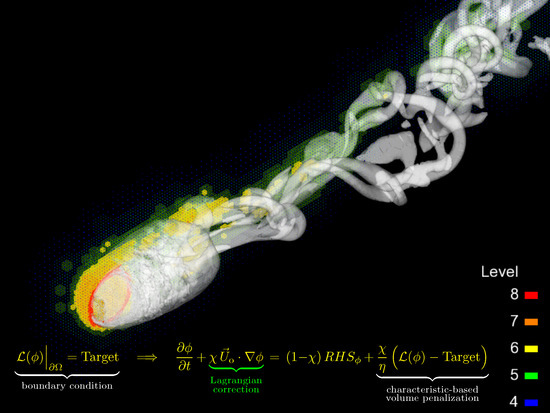Galilean-Invariant Characteristic-Based Volume Penalization Method for Supersonic Flows with Moving Boundaries
Abstract
1. Introduction
2. Characteristic-Based Volume Penalization
2.1. Mathematical Formulation
2.2. Volume Penalization of Euler Equations
2.3. Volume Penalization of Navier–Stokes Equations
2.4. Moving Obstacles
2.5. Adaptive Wavelet Collocation Method
3. Numerical Results and Discussion
3.1. Benchmark I: Normal Shock Wave Reflection
3.2. Benchmark II: Oblique Shock Wave
3.3. Benchmark III: Two-Dimensional Supersonic Flows around Blunt Bodies
3.4. Benchmark IV: Galilean Invariance
4. Conclusions
Author Contributions
Funding
Conflicts of Interest
Abbreviations
| AMR | adaptive mesh refinement |
| AWC | adaptive wavelet collocation |
| BP | Brinkman penalization |
| CBVP | characteristic-based volume penalization |
| GI-CBVP | Galilean-invariant characteristic-based volume penalization |
| IB | immersed boundary |
| PDEs | partial differential equations |
| VP | volume penalization |
References
- Thompson, J.F.; Warsi, Z.U.A.; Mastin, C.W. Boundary fitted coordinate systems for numerical solution of partial differential equations—A review. J. Comput. Phys. 1982, 47, 1–108. [Google Scholar] [CrossRef]
- Thomas, P.D.; Middlecoff, J.F. Direct control of the grid point distribution in meshes generated by elliptic equations. AIAA J. 1980, 18, 652–656. [Google Scholar] [CrossRef]
- Kaul, U.K. Three-dimensional elliptic grid generation with fully automatic boundary constraints. J. Comput. Phys. 2010, 229, 5966–5979. [Google Scholar] [CrossRef]
- Peskin, C.S. The immersed boundary method. Acta Numer. 2002, 11, 479–517. [Google Scholar] [CrossRef]
- Tseng, Y.H.; Ferziger, J.H. A ghost-cell immersed boundary method for flow in complex geometry. J. Comput. Phys. 2003, 192, 593–623. [Google Scholar] [CrossRef]
- Mittal, R.; Iaccarino, G. Immersed boundary methods. Annu. Rev. Fluid Mech. 2005, 37, 239–261. [Google Scholar] [CrossRef]
- Fadlun, E.A.; Verzicco, R.; Orlandi, P.; Mohd-Yusof, J. Combined immersed-boundary finite-difference methods for three-dimensional complex flow simulations. J. Comput. Phys. 2000, 161, 35–60. [Google Scholar] [CrossRef]
- Arquis, E.; Caltagirone, J.P. Sur les conditions hydrodynamiques au voisinage d’une interface milieu fluide-milieu poreux: Application à la convection naturelle. CR Acad. Sci. Paris II 1984, 299, 1–4. [Google Scholar]
- Lai, M.C.; Peskin, C.S. An immersed boundary method with formal second order accuracy and reduced numerical viscosity. J. Comput. Phys. 2000, 160, 705–719. [Google Scholar] [CrossRef]
- Saiki, E.M.; Biringen, S. Numerical simulation of a cylinder in uniform flow: Application of a virtual boundary method. J. Comput. Phys. 1996, 123, 450–465. [Google Scholar] [CrossRef]
- Goldstein, D.; Handler, R.; Sirovich, L. Modeling a no-slip flow boundary with an external force field. J. Comput. Phys. 1993, 105, 354–366. [Google Scholar] [CrossRef]
- Angot, P.; Bruneau, C.; Fabrie, P. A penalization method to take into account obstacles in viscous flows. Numer. Math. 1999, 81, 497–520. [Google Scholar] [CrossRef]
- Feireisl, E.; Neustupa, J.; Stebel, S. Convergence of a Brinkman-type penalization for compressible fluid flows. J. Differ. Equ. 2011, 250, 596–606. [Google Scholar] [CrossRef]
- Carbou, G.; Fabrie, P. Boundary layer for a penalization method for viscous incompressible flow. Adv. Differ. Equ. 2003, 8, 1453–1480. [Google Scholar]
- Peskin, C.S. Flow Patterns around Heart Valves: A Digital Computer Method for Solving the Equations of Motion. Ph.D. Thesis, Albert Einstein College of Medicine, New York, NY, USA, 1972. [Google Scholar]
- Purvis, J.W.; Burkhalter, J.E. Prediction of critical mach number for store configurations. AIAA J. 1979, 17, 1170–1177. [Google Scholar] [CrossRef]
- Clarke, D.K.; Salas, M.D.; Hassen, H.A. Euler calculations for multielement airfoils using cartesian grids. AIAA J. 1986, 24, 353–358. [Google Scholar] [CrossRef]
- Zeeuw, D.D.; Powell, K.G. An adaptively refined cartesian mesh solver for the Euler equations. J. Comput. Phys. 1993, 104, 56–68. [Google Scholar] [CrossRef][Green Version]
- Berger, M.J.; Aftosmis, M.J. Aspects (and aspect ratios) of cartesian mesh methods. In Proceedings of the Sixteenth International Conference on Numerical Methods in Fluid Dynamics, Arcachon, France, 6–10 July 1998. [Google Scholar]
- Khadra, K.; Angot, P.; Parneix, S.; Caltagirone, J.P. Fictitious domain approach for numerical modelling of Navier-Stokes equations. Int. J. Numer. Methods Fluids 2000, 34, 651–684. [Google Scholar] [CrossRef]
- Kevlahan, N.R.; Ghidaglia, J.M. Computation of turbulent flow past an array of cylinders using a spectral method with Brinkman Penalization. Eur. J. Mech. B Fluids 2001, 20, 333–350. [Google Scholar] [CrossRef]
- Reckinger, S.; Vasilyev, O.V.; Fox-Kemper, B. Adaptive Volume Penalization for Ocean Modeling. Ocean Dyn. 2012, 62, 1201–1215. [Google Scholar] [CrossRef]
- Kevlahan, N.K.R.; Vasilyev, O.V. An adaptive wavelet collocation method for fluid-structure interaction at high Reynolds numbers. SIAM J. Sci. Comput. 2005, 26, 1894–1915. [Google Scholar] [CrossRef]
- Pasquetti, R.; Bwemba, R.; Cousin, L. A pseudo-penalization method for high Reynolds number unsteady flows. Appl. Numer. Math. 2007, 58, 946–954. [Google Scholar] [CrossRef]
- Jause-Labert, C.; Godeferd, F.; Favier, B. Numerical validation of the volume penalization method in three-dimensional pseudo-spectral simulations. Comput. Fluids 2012, 67, 41–56. [Google Scholar] [CrossRef]
- Kolomenskiy, D.; Schneider, K. A Fourier spectral method for the Navier–Stokes equations with volume penalization for moving solid obstacles. J. Comput. Phys. 2009, 228, 5687–5709. [Google Scholar] [CrossRef]
- Engels, T.; Kolomenskiy, D.; Schneider, K.; Sesterhenn, J. FluSI: A novel parallel simulation tool for flapping insect flight using a Fourier method with volume penalization. SIAM J. Sci. Comput. 2016, 38, S3–S24. [Google Scholar] [CrossRef]
- Ramière, I.; Angot, P.; Belliard, M. A fictitious domain approach with spread interface for elliptic problems with general boundary conditions. Comput. Methods Appl. Mech. Eng. 2007, 196, 766–781. [Google Scholar] [CrossRef]
- Vasilyev, O.V.; Kevlahan, N.K.R. Hybrid Wavelet Collocation-Brinkman Penalization Method for Complex Geometry Flows. Int. J. Numer. Methods Fluids 2002, 40, 531–538. [Google Scholar] [CrossRef]
- Schneider, K.; Farge, M. Adaptive wavelet simulation of a flow around an impulsively started cylinder using penalisation. Appl. Comput. Harmon. Anal. 2002, 12, 374–380. [Google Scholar] [CrossRef]
- Wirasaet, D.; Paolucci, S. Adaptive wavelet method for incompressible flows in complex domains. J. Fluids Eng. 2005, 127, 656–665. [Google Scholar] [CrossRef]
- Keetels, G.H.; D’Ortona, U.; Kramer, W.; Clercx, H.J.H.; Schneider, K.; Van Heijst, G.J.F. Fourier spectral and wavelet solvers for the incompressible Navier-Stokes equations with volume-penalization: Convergence of a dipole-wall collision. J. Comput. Phys. 2007, 227, 919–945. [Google Scholar] [CrossRef]
- Ghias, R.; Mittal, R.; Lund, T.S. A non-body conformal grid method for simulation of compressible flows with complex immersed boundaries. In Proceedings of the 42nd AIAA Aerospace Sciences Meeting and Exhibit, Reno, NV, USA, 5–8 January 2004. [Google Scholar]
- Cohen, R.; Ooi, A.; Iaccarono, G. Towards the application of the impedance mismatch method to the expansion about incompressible flow acoustic equations. In Proceedings of the Summer Program 2006, Kiten, Bulgaria, 3–9 July 2006. [Google Scholar]
- Chung, C. Wave Propagation and Scattering in Computational Aeroacoustics. Ph.D. Dissertation, Department of Aerospace Engineering, Pennsylvania State University, University Park, PA, USA, 1995. [Google Scholar]
- Liu, Q.; Vasilyev, O.V. A Brinkman penalization method for compressible flows in complex geometries. J. Comput. Phys. 2007, 227, 946–966. [Google Scholar] [CrossRef]
- Bae, Y.; Moon, Y. On the use of Brinkman Penalization Method for computation of acoustic scattering from complex boundaries. Comput. Fluids 2012, 55, 48–56. [Google Scholar] [CrossRef]
- Bernardini, M.; Modesti, D.; Pirozzoli, S. On the suitability of the immersed boundary method for the simulation of high-Reynolds-number separated turbulent flows. Comput. Fluids 2016, 130, 84–93. [Google Scholar] [CrossRef]
- De Vanna, F.; Picano, F.; Benini, E. A sharp-interface immersed boundary method for moving objects in compressible viscous flows. Comput. Fluids 2020, 201, 104415. [Google Scholar] [CrossRef]
- Ehsan Khalili, M.; Larsson, M.; Müller, B. Immersed boundary method for viscous compressible flows around moving bodies. Comput. Fluids 2018, 170, 77–92. [Google Scholar] [CrossRef]
- Boukharfane, R.; Ribeiro, F.; Bouali, Z.; Mura, A. A combined ghost-point-forcing / direct-forcing immersed boundary method (IBM) for compressible flow simulations. Comput. Fluids 2018, 162, 91–112. [Google Scholar] [CrossRef]
- Piquet, A.; Roussel, O.; Hadjadj, A. A comparative study of Brinkman penalization and direct-forcing immersed boundary methods for compressible viscous flows. Comput. Fluids 2016, 136, 272–284. [Google Scholar] [CrossRef]
- Brown-Dymkoski, E.; Kasimov, N.; Vasilyev, O.V. A characteristic based volume penalization method for general evolution problems applied to compressible viscous flows. J. Comput. Phys. 2014, 262, 344–357. [Google Scholar] [CrossRef]
- Brown-Dymkoski, E.; Kasimov, N.; Vasilyev, O.V. Characteristic-based volume penalization method for arbitrary Mach flows around solid obstacles. In Direct and Large-Eddy Simulation IX; Frohlich, J., Kuerten, H., Geurts, B., Armenio, V., Eds.; ERCOFTAC Series; Springer: Berlin/Heidelberg, Germany, 2015; pp. 109–115. [Google Scholar]
- Lavoie, P.; Radenac, E.; Blanchard, G.; Laurendeau, É.; Villedieu, P. An improved characteristic based volume penalization method for the Euler equations towards icing applications. Comput. Fluids 2021, 222. [Google Scholar] [CrossRef]
- Komatsu, R.; Iwakami, W.; Hattori, Y. Direct numerical simulation of aeroacoustic sound by volume penalization method. Comput. Fluids 2016, 130, 24–36. [Google Scholar] [CrossRef]
- Thompson, J.F.; Soni, B.K.; Weatherill, N.P. (Eds.) Handbook of Grid Generation; CRC Press: Boca Raton, FL, USA; London, UK; New York, NY, USA, 1999. [Google Scholar]
- Vasilyev, O.V.; Bowman, C. Second-Generation Wavelet Collocation Method for the Solution of Partial Differential Equations. J. Comput. Phys. 2000, 165, 660–693. [Google Scholar] [CrossRef]
- Vasilyev, O.V. Solving Multi-Dimensional Evolution Problems with Localized Structures Using Second Generation Wavelets. Int. J. Comput. Fluid Dyn. 2003, 17, 151–168. [Google Scholar] [CrossRef]
- Vasilyev, O.V.; Kevlahan, N.K.R. An adaptive multilevel wavelet collocation method for elliptic problems. J. Comput. Phys. 2005, 206, 412–431. [Google Scholar] [CrossRef]
- Nejadmalayeri, A.; Vezolainen, A.; Brown-Dymkoski, E.; Vasilyev, O.V. Parallel Adaptive Wavelet Collocation Method for PDEs. J. Comput. Phys. 2015, 298, 237–253. [Google Scholar] [CrossRef]
- De Stefano, G.; Brown-Dymkoski, E.; Vasilyev, O.V. Wavelet-based adaptive large-eddy simulation of supersonic channel flow. J. Fluid Mech. 2020, 901, A13. [Google Scholar] [CrossRef]
- Regele, J.; Vasilyev, O.V. An adaptive wavelet-collocation method for shock computations. Int. J. Comput. Fluid Dyn. 2009, 23, 503–518. [Google Scholar] [CrossRef]
- De Stefano, G.; Vasilyev, O.V. Wavelet-based adaptive simulations of three-dimensional flow past a square cylinder. J. Fluid Mech. 2014, 748, 433–456. [Google Scholar] [CrossRef]
- De Stefano, G.; Nejadmalayeri, A.; Vasilyev, O.V. Wall-resolved wavelet-based adaptive large-eddy simulation of bluff-body flows with variable thresholding. J. Fluid Mech. 2016, 788, 303–336. [Google Scholar] [CrossRef]
- Schneider, K.; Vasilyev, O.V. Wavelet methods in computational fluid dynamics. Annu. Rev. Fluid Mech. 2010, 42, 473–503. [Google Scholar] [CrossRef]
- De Stefano, G.; Vasilyev, O.V. Hierarchical adaptive eddy-capturing approach for modeling and simulation of turbulent flows. Fluids 2021, 6, 83. [Google Scholar] [CrossRef]
- Sethian, J.A. Level Set Methods; Cambridge University Press: Cambridge, UK, 1996. [Google Scholar]
- Toro, E. Riemann Solvers and Numerical Methods for Fluid Dynamics: A Practical Introduction, 3rd ed.; Springer: Berlin/Heidelberg, Germany, 2009. [Google Scholar]
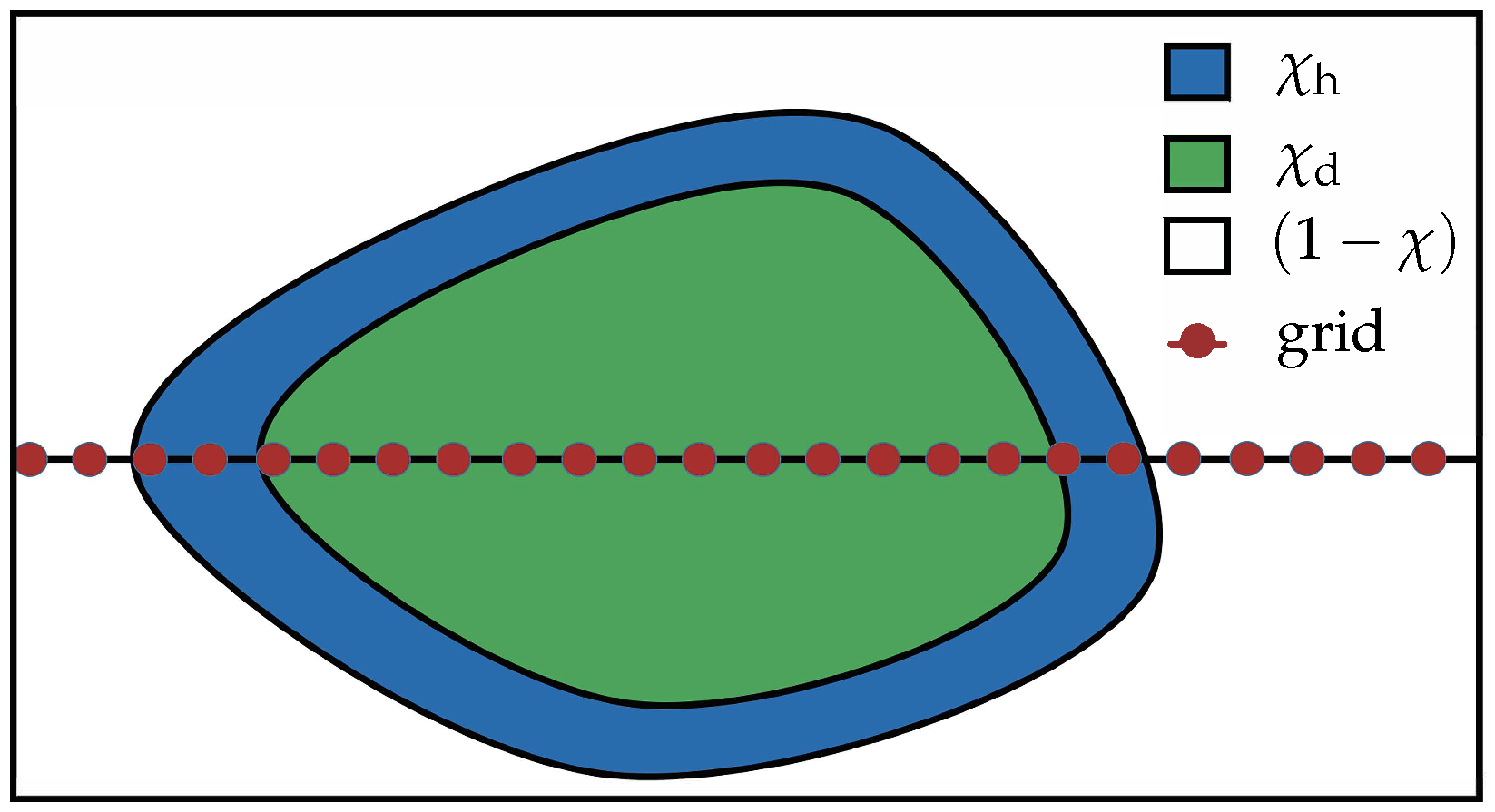
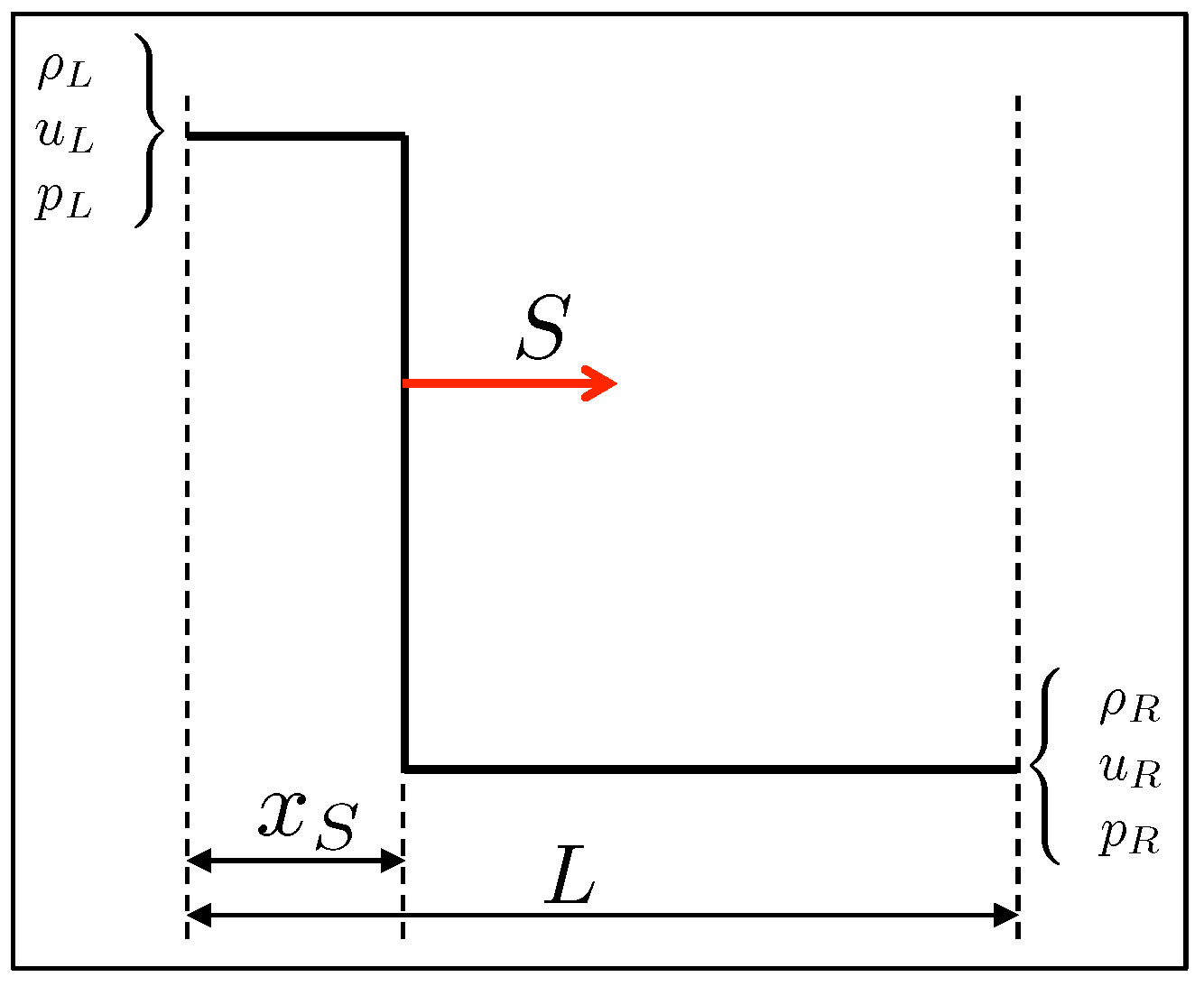


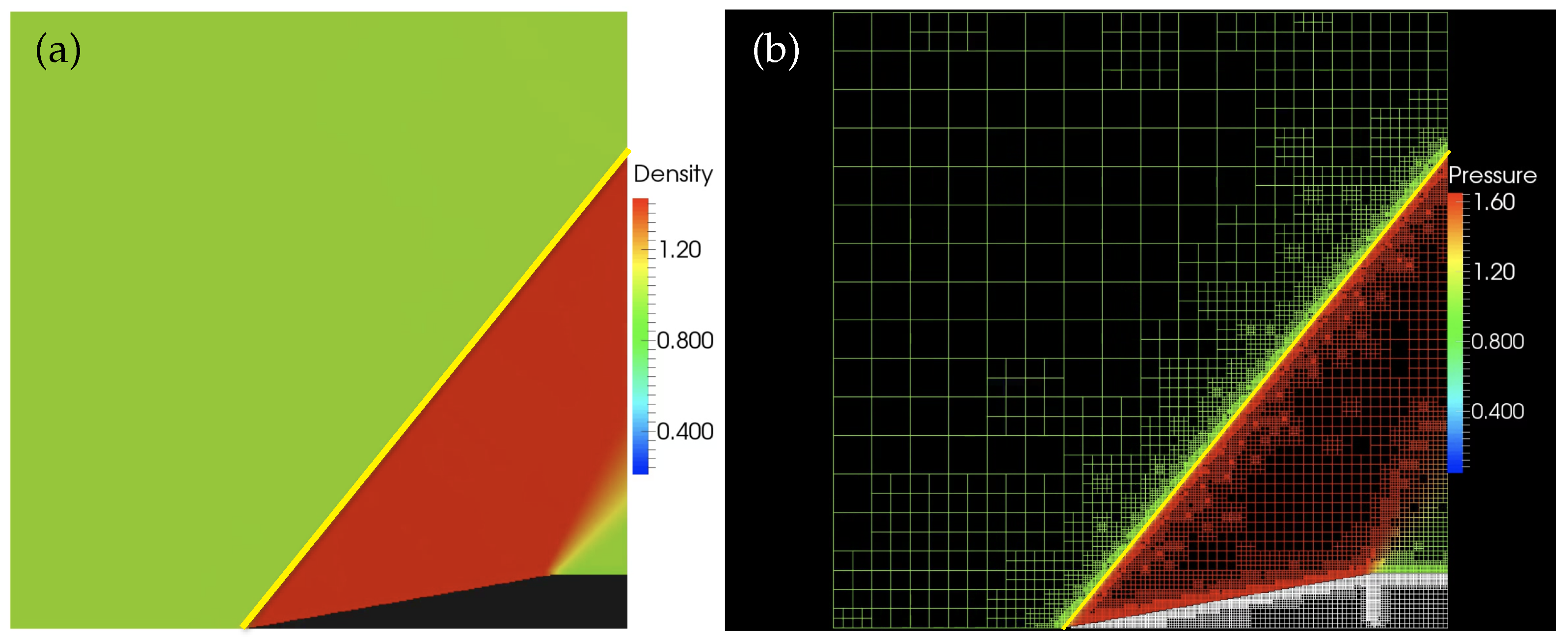
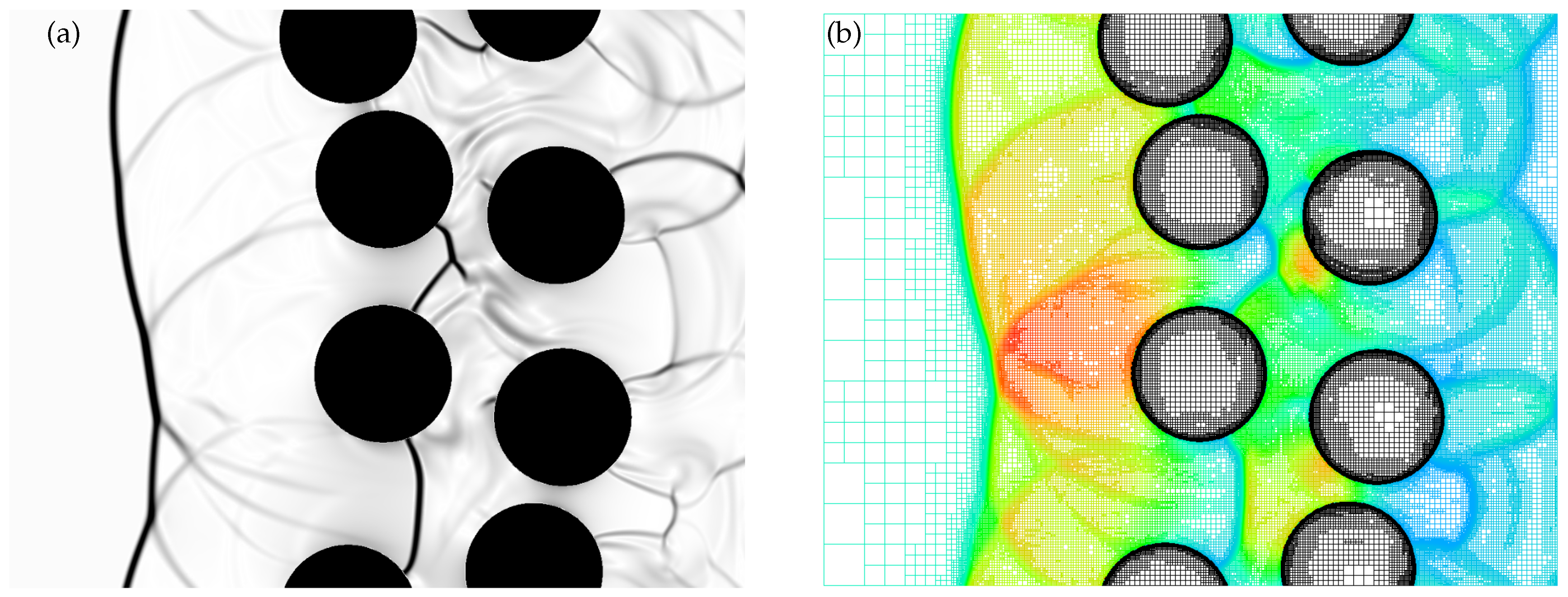

Publisher’s Note: MDPI stays neutral with regard to jurisdictional claims in published maps and institutional affiliations. |
© 2021 by the authors. Licensee MDPI, Basel, Switzerland. This article is an open access article distributed under the terms and conditions of the Creative Commons Attribution (CC BY) license (https://creativecommons.org/licenses/by/4.0/).
Share and Cite
Kasimov, N.; Dymkoski, E.; De Stefano, G.; Vasilyev, O.V. Galilean-Invariant Characteristic-Based Volume Penalization Method for Supersonic Flows with Moving Boundaries. Fluids 2021, 6, 293. https://doi.org/10.3390/fluids6080293
Kasimov N, Dymkoski E, De Stefano G, Vasilyev OV. Galilean-Invariant Characteristic-Based Volume Penalization Method for Supersonic Flows with Moving Boundaries. Fluids. 2021; 6(8):293. https://doi.org/10.3390/fluids6080293
Chicago/Turabian StyleKasimov, Nurlybek, Eric Dymkoski, Giuliano De Stefano, and Oleg V. Vasilyev. 2021. "Galilean-Invariant Characteristic-Based Volume Penalization Method for Supersonic Flows with Moving Boundaries" Fluids 6, no. 8: 293. https://doi.org/10.3390/fluids6080293
APA StyleKasimov, N., Dymkoski, E., De Stefano, G., & Vasilyev, O. V. (2021). Galilean-Invariant Characteristic-Based Volume Penalization Method for Supersonic Flows with Moving Boundaries. Fluids, 6(8), 293. https://doi.org/10.3390/fluids6080293






